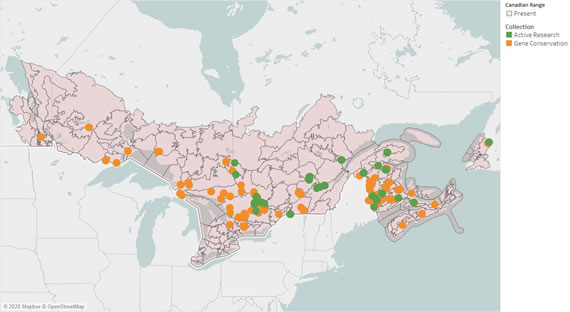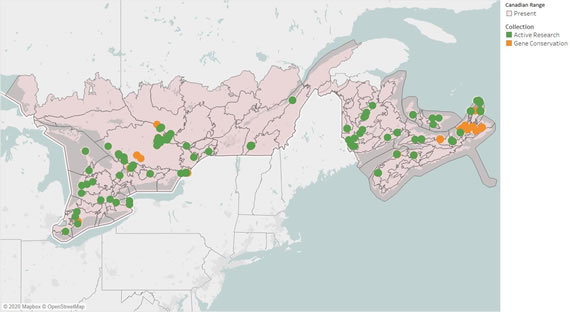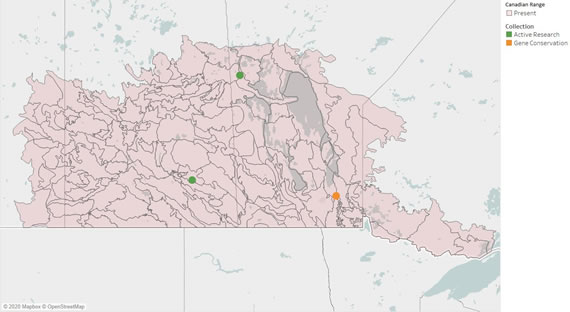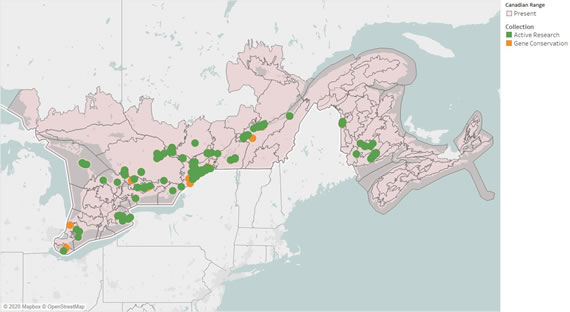
News, Research and Services newsletter.
The National Tree Seed Centre (NTSC) is Canada’s only national seed bank preserving the genetic diversity of Canada’s forests.
Seed collection is an ex-situ conservation tool (stored off-site), which ensures material is available when needed and away from potential risks that could impact a forest such as development, fire, drought and pests. Seed storage is an efficient means of conserving genetic variation, as a large quantity of material can be stored in a relatively small space.
Through partner training and technical support, the NTSC follows global seed conservation standards to create and maintain high-quality seed collections.
Our seed collections can be made available to collaborators or reserved by terms of Memorandums of Understanding (MOUs) and/or knowledge transfer agreements (KTAs). We can establish MOUs or KTAs with all levels of government, Indigenous communities, academic institutions, private and not-for-profit organizations.
Organizations pursuing a seed collection strategy are encouraged to contact the NTSC early in their planning process. In addition to training and technical support for high-quality seed, the NTSC will evaluate the capacity to test and store all or a portion of collections in partnership with local collaborators. For jurisdictions and organizations scaling up reforestation, reclamation and restoration programs, a long-term seed banking strategy can offer insurance against in situ risks. It can also support research and development efforts.
Private citizens and citizen science projects can also donate seed to our seed conservation programs. Please contact the Centre prior to collecting.
Seed collecting and handling
Most seed at the NTSC is collected from natural populations by our staff. The availability of single-tree collections and seed origin data maximize the research value of our collections. Most tree species do not flower or produce good seed every year, so forecasting and cut testing is done each field season to determine which species should be prioritized.
NTSC staff use a variety of methods to collect seed including:
- climbing trees
- using pole pruners or ladders
- from trees felled as a result of harvesting operations
Collections may be taken from individual trees or bulked from many trees to acquire a representative sample of the genetic variability of the population. Representative collections are acquired with the assistance of:
- Canadian Forest Service research centers
- Parks Canada
- provincial / territorial forest services
- forest industries
- indigenous collaborators
- other agencies
Some seed is obtained through exchange or purchase from seed dealers. However, to ensure high genetic and physiological seed quality, collections are only made or purchased when there is a good crop.
Read more about how to ensure seed collections maximize wild genetic variation in the Conservation of Forest Genetics of Canada (CONFORGEN) guidelines for collecting and storing seed for ex situ conservation.
Post-harvest handling and gentle extraction is critical to maximize seed quality. Adequate air circulation and temperature should be monitored daily to ensure cones and fruit do not overheat after collection and in transit. Upon receipt, each collection is registered and prioritized according to its seed storage behaviour.
The NTSC uses a variety of techniques to process all collections down to pure seed, including:
- tumbling
- winnowing
- floating
- aspirating
- sieving
- gravity separation
- ethanol separation
Testing
At the NTSC, seed testing is conducted on a regular and continuous basis. Routine seed testing includes:
- moisture content
- water activity
- thousand seed weight
- germination
- excised embryo
- tetrazolium
Germination testing rules established by the International Seed Testing Association and Association of Official Seed Analysts are followed or used as a guide. The NTSC also conducts in-house experiments to determine optimal dormancy breaking treatments and improvements to seed vigour. The best treatments are published in our annual reports and integrated to our regular germination treatment guidelines.
To obtain a copy of NTSC’s seed germination treatments or results on any of the species in NTSC’s Seed Database, please contact the Centre.
Storage
Seed that can be dried (called “orthodox” in behaviour) is stored at the NTSC in –20°C walk-in freezers. At this temperature, seeds stay viable for decades, as long as their moisture content is low (3 to 7%).
For example, seed from white spruce (Picea glauca), black spruce (Picea mariana), jack pine (Pinus banksiana) and red pine (Pinus resinosa) has germinated at over 80% after 45 to 55 years in frozen storage. For hardwood species whose seed cannot be dried and do not store well, such as oak (Quercus spp) and silver maple (Acer saccharinum), seeds are kept moist at 4°C and collections are made frequently to maintain a viable supply.
Exceptional and/or challenging species and valuable germplasm are stored long-term in liquid nitrogen tanks at –196°C.
Seed conservation programs
High-value breeding and foundational seedlots are often stored for decades to support:
- climate adaptation research
- provenance testing
- tree improvement programs
All collections count toward Canada’s biodiversity targets and reporting, as is demonstrated through State of Canada’s Forest Genetic Resources reports and Plant Genetic Resources for Agriculture.
Conservation of Butternut genetic resources
Butternut (Juglans cinerea), is a tree species native to Canada and the United States. It is being killed by an introduced fungal disease (Ophiognomonia clavigignenti-juglandacearum), which causes butternut canker.
In Canada, butternut is on the endangered species list under the federal Species at Risk Act. This means the tree is at serious risk of becoming extinct.
Where butternut grows in Canada
Butternut is native to southern Ontario and Quebec and western and southern New Brunswick. It is typically found growing in small stands near or with other mixed hardwoods. The New Brunswick populations are genetically distinct from those in the other two provinces and in the United States.
In New Brunswick, the species grows mainly in the Saint John River Valley and along the banks of the Southwest Miramichi River and the Aroostock River.
The need for an ex situ conservation strategy
No control for the fungal disease yet exists, and no butternut trees appear to be resistant to the disease.
Research in the United States has found that the species has little genetic basis for resistance. Although resistance to canker initiation brought on by the fungus is genetically present, it is not enough to be incorporated into a resistance breeding program. This conclusion supports previous findings that suggest resistance is not heritable in butternut.
For this reason, in situ conservation (meaning on site, or nearby, on lands such as parks or protected areas) is not an effective long-term strategy for the endangered butternut.
At the Atlantic Forestry Centre, a project is underway to develop an ex situ (off site) butternut conservation collection. This will be one of only a few resources available to researchers to support future research and restoration of the species using next-generation technologies.
Research activities underway
This project, which started in 2013, includes activities such as:
- cryopreserving embryonic axes
- cryopreservation involves storing material in liquid nitrogen at -196°C
- for four years (2013 to 2016), over 28,000 nuts were collected throughout New Brunswick
- about 21,500 embryonic axes from these were stored in liquid nitrogen at the NTSC
- assessing butternut populations across its range in New Brunswick and evaluating the health of these populations
- genotyping butternut populations in New Brunswick to evaluate the extent of its genetic diversity
- during three years of surveying (2014 to 2016), samples from over 600 trees on more than 40 sites in New Brunswick were collected
- all of these samples will be genotyped
A database maintained at the Atlantic Forestry Centre on the New Brunswick butternut population includes:
- tree identification and genotyping data
- tree health assessment data, such as tree physical traits and health parameters (diameter at breast height, presence of canker, crown vigour, dieback, etc.)
- information about the ex situ collection of nuts, including number of nuts, measurement data and embryonic axes storage data
These genetic data enable us to evaluate the uniqueness of the New Brunswick butternut population.
For more information, contact the Martin Williams
Conservation of ash genetic resources
Emerald ash borer (EAB), an exotic insect, poses an economic and environmental threat to ash trees in Canada.
The larvae bore into the tree, creating tunnels in the wood under the bark. These tunnels disrupt water and nutrient flow, killing the tree. Every ash species is susceptible, which means EAB threatens the existence of ash in Canada. It is therefore important to collect ash seed before Canada’s ash resource is decimated.
The National Forest Seed Centre was the first Canadian facility to collect ash seed for genetic conservation.
How to identify ash species correctly
It is essential to collect seed from correctly identified trees. Characteristics can vary within a species and a tree of one species can sometimes look like another species. Therefore it is necessary to examine all characteristics to make an accurate identification. Trees are best identified and flagged in August, well before seed collection time.
If you cannot definitively identify the species, DO NOT collect the seed. When submitting collected seed, include a sample twig and pressed leaf from the tree in question.
For assistance with ash identification, consult:
- our Quick Identification Guide.
- the Trees, insects and diseases of Canada’s forests website
- a recognized field identification guide, such as Trees in Canada by J.L. Farrar.
When to collect ash seed
- Ensure that seed is ripe before collecting it
- collecting too early will result in seed that is not completely mature
- collecting too late will result in losing seed to natural seed fall
- Black ash is usually ready to collect by mid-September
- All other ash species are ready to collect after the end of September
Where to collect ash seed
- Collect seed from natural stands only.
- Do not collect from planted trees such as in parks, along streets or on residential properties.
- seed used to grow these trees may have originated elsewhere and not be well adapted to the growing conditions of the site it is planted on
- Within a stand or area, collect seed from at least 10 trees (more if possible).
- Where possible collections should be from trees located at least 50 metres apart.
Maps of current NTSC Ash collections
- Regions without current collections in conservation will be the focal point for the NTSC, and collaborators in the coming years.

Figure 1 – Black ash, Canadian ecodistricts with NTSC collections sites (2020).
Larger image [295 Kb JPG]

Figure 2 – White ash, Canadian ecodistricts with NTSC collections sites (2020).
Larger image [274 Kb JPG]

Figure 3 – Green ash, western Canadian ecodistricts with NTSC collections sites (2020).
Larger image [297 Kb JPG]

Figure 4 – Green ash, eastern Canadian ecodistricts with NTSC collections sites (2020).
Larger image [279 Kb JPG]
Map sources
All maps sourced from the NTSC collection database (1948-2020), USDA, USGS, Canadian Council on Ecological Areas (CCEA 2017), Mapbox and Openstreet Map. Tableau Desktop 2019.4.7 licence provided by the Forest Gene Conservation Association of Ontario.
For more information on the Canadian Ecological Land Classification (ELC) classification, visit Introduction to the Ecological Land Classification (ELC) 2017.
How to collect ash seed:
- Place seed collected from individual trees into separate bags, one for each tree.
- use large paper grocery bags, which will aid in allowing the seed to dry. NEVER use plastic bags
- assign a number to each tree and clearly label the paper bag with this number as well as the tree’s location
- place a label with the corresponding information inside the bag
- Collect seed directly from the tree, NEVER from the ground as seed on the ground could be from any tree.
- Check a sample of seed for insect damage and to ensure the seeds are filled before starting to collect
- if seed quality is low, move to another tree
- keep in mind that seed quality varies from tree to tree
- Collect 2 to 6 litres from each tree, including seed and associated stems of the seed clusters.
- Use pole pruners to cut off branches
- if a ladder is required to climb up into a tree, ensure that someone is trained to do this and the appropriate safety equipment is used
- Collect seed from harvested trees as long as the trees were cut when the seed was ripe and fully mature
- Place the bags in a well-ventilated area to allow the collected seed to dry.
Information to record
- Record the following information for each tree that seed is collected from:
- name of collector
- collection date
- the number you assigned to the tree
- location (place name)
- GPS coordinates in decimal degrees for each tree (latitude and longitude)
- elevation
- site description
- Make a copy for your records and send the original to us with the seed.
How to pack ash the seed for sending
- When the seed has air-dried for several weeks, staple the bags closed
- Pack each carefully, along with its related twig and pressed leaf samples, in a box (or in as many boxes as needed)
- The leaf samples should be kept flat and separate by tree
- All samples can be sandwiched between two pieces of corrugated cardboard
Seed shipments
Before collecting seed, please send a photograph of cut testing results to us.
If shipping seeds to the NTSC, please ensure collections follow our seed collection and conservation guidelines.
Seed is sent by regular mail at no charge or by courier at the requester’s expense. An Import Permit may be required for seed requests from outside Canada.
Once a permit is received, the NTSC will obtain a Phytosanitary Certificate, which will accompany the shipment.
Before sending your shipment, call or email us to confirm arrangements.
Send tracking numbers and packing slips to Donnie McPhee
Send boxes of seed by courier to:
Atlantic Forestry Centre, National Tree Seed Centre
1350 Regent Street
Fredericton, NB E3C 2G6
Attention: Donnie McPhee, NTSC Coordinator
Tel: 506-452-4162
Fax: 506-452-3525
Mobile: 506-260-7309
For more information contact the National Tree Seed Centre.
- Conservation of Forest Genetics of Canada (CONFORGEN) - Guidelines for collecting and storing seed for ex situ conservation
- Silvics of North America: Volume 1 – Conifers
- Silvics of North America: Volume 2 – Hardwoods
- Woody Plant Seed Manual